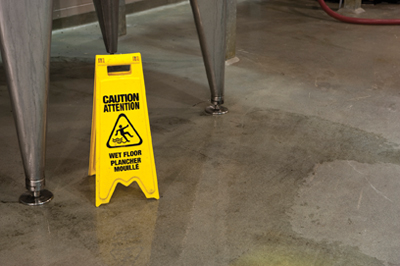
Features
Safety
Wings on safetly: Mission possible
“The after-effects of the accident transpired more slowly. Workers who witnessed the scene were too shaken up to resume their duties. Production stopped until an investigation was completed.
February 8, 2010 By Carola Hicks
They all left for work in the morning expecting to return home safely. (Names below have been changed.)
 |
|
| A simple preventable accident can have far-reaching ramifications.
|
- Phil Carson was a 24-year-old window maker when he had his accident at work. A fellow worker lit a cigarette, which ignited the fumes from the window casting he was handling. He sustained 75 per cent burns over his body and was left with serious facial, hand and body scarring.
- Sandra Fox slipped at work on a wet patch on the floor, suffering a back injury. She had to stop work permanently and suffered from depression that resulted from having to give up her job.
- James Fuller fell off scaffolding at work, resulting in serious injury. There were no witnesses and the cause of the fall was unclear. Mr. Fuller subsequently died.
The cost implications add up exponentially
“The after-effects of the accident transpired more slowly. Workers who witnessed the scene were too shaken up to resume their duties. Production stopped until an investigation was completed. Managers reassigned the injured worker, called in a replacement, and explained the duties. The supervisor filled out a lengthy accident report and several regulatory forms. The plant owner prepared for possible litigation.”
Could you afford the expense of having a worker injured in your company? In most cases, such accidents and the accompanying loss of production and efficiency can be avoided by establishing manager/employee safety committees, instituting regular training programs and inspections and conducting emergency drills, to name just a few preventive solutions. Certainly the most quantifiable benefit of a successful safety program is a reduction in injuries and workers’ compensation insurance rates.
Achieving occupational health and safety
There will always be workplace hazards and risks to worker safety. An excellent safety program starts and ends with demonstrated management commitment to ongoing improvement of safety processes. At the most fundamental level, the aim is improved safety through proactive management, rather than reactive compliance with regulatory requirements.
When management gives equal weight to process improvement and accident prevention, the end result is safer workers and workplaces. The term “safety management” suggests a systematic, managerial process that requires accountability and must be considered at the same level as all other managerial processes. Only when this is the case can management truly demonstrate commitment to the health and safety of its workers.
An effective safety program includes safety objectives and targets; safety incident reports; safety hazard and risk assessments; safety meeting management; work observations; safety policies; training management; document controls; records management; audits management; non-conformance/corrective/preventive actions; permits and other legal requirements; maintenance, measuring and reporting; emergency response; and operational controls.
Due diligence
Companies are expected to use due diligence to follow provincial Occupational Health and Safety Act (OHS Act) laws to prevent accidents. “Due diligence” is a rule created by the Supreme Court of Canada that, in effect, requires the taking of reasonable steps in the circumstances to guard against foreseeable risks. To decide on a due diligence defence, a court has to compare what an employer should have done to prevent an accident against what was actually done. In other words, the court must judge actions against a standard of reasonable safety.
Every industry or workplace sector is required to meet legislated guidelines. The success of any health and safety plan will be determined by its ability to maintain compliance and a clean safety record over a long period of time. Understanding, implementing and communicating an organization’s responsibilities and preventive measures all help ensure compliance with the law.
It is imperative that everyone understands that a world-class safety culture cannot be created by simply wishing it so. It is a continuous journey of improvement that goes beyond the traditional three E’s of safety – Education, Enforcement and Engineering – and focuses on culture and values, leadership practices, organizational issues, structure and behaviour, which are all strategies of excellence.
We all leave for work in the morning expecting to return home safely at the end of the day…
Carola Hicks is CEO of Workplace Safety Group, experts in workplace safety. She writes health-and-safety-related articles for industry-specific magazines and assists in the development of custom training programs. carola@workplacesafetygroup.com.
This information is intended to increase overall safety awareness and is not a substitute for compliance with regulatory guidelines.
We welcome your feedback at akwasnik@annexweb.com.